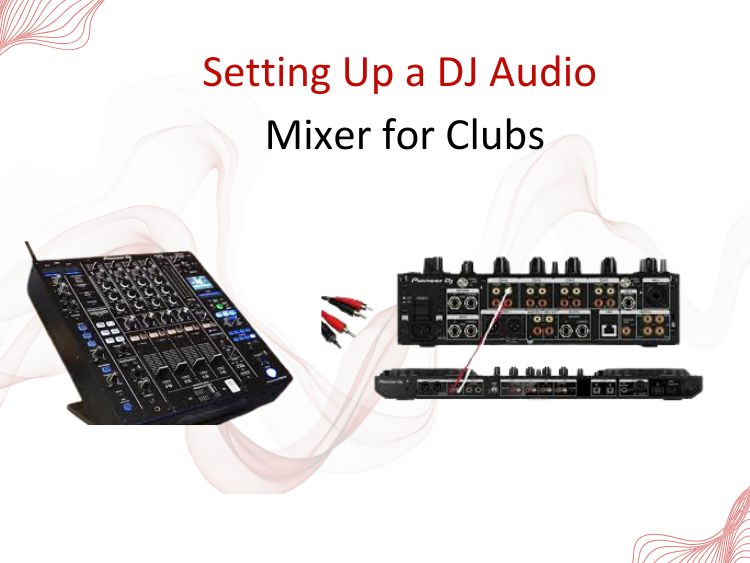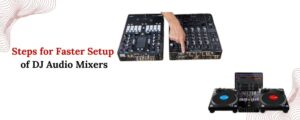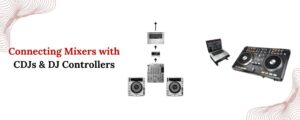Correct setup of your DJ mixer is essential for delivering a flawless performance whether you are a seasoned DJ or stepping into the club scene for the first time. A properly configured setup not only guarantees sound quality, but also helps avoid potential issues during your set. In a club, where the sound systems are powerful and expectations are high, attention to detail can break or make your gig.
This guide will walk you through the steps of setting up a DJ mixer for club performances.
Steps to Set Up a DJ Mixer for Club Performances
Know the Club’s Setup
Before bringing your equipment, look for what the club offers. Most venues have DJ mixers, turntables, CDJs, and audio interfaces hooked up. Some even allow direct connections to DJ software like Serato and Rekordbox. Contact the club manager or sound tech and ask:
- What model of mixer do they have?
- Are the decks CDJs, turntables, or controllers?
- Are there RCAs, XLR, or digital outputs?
- Is there a booth monitor?
Having this information will assist you in assessing what else you need to bring, like additional cables, a laptop holder, or even your personal mixer.
Assemble Mixers at the Booth
Coordinate the club visit using the joystick for the turntable. Place it in a well-balanced and focusable area. It should be reachable, and faders, knobs, EQs, should be in a position to be seen. Most of the DJ booths do not have a lot of space, so placement, form, and compactness matter.
Ensure the mixer remains free from potential spills or heavy foot traffic. Raising it slightly should help to avoid accidental drink spilling, subwoofer vibration, or shock from being physically blasted.
Connect the Audio Sources
Your setup may comprise:
- CDJs
- Turn Tables
- DJ Controllers
- USB or Laptops
Always plug each deck to the line or phono inputs on the mixer. Remember:
- PHONO is for turntables and LINE is for CDJs/media players.
- The selected source for the mixer input must be in the right position.
- For optimum signal integrity, high-quality RCA or digital cables, if available, should be used.
In case of a laptop, plug in the audio interface or controller to the mixer channels. A number of new age mixers now come equipped with USB ports that function as soundcards for auxiliaries.
Connect the club’s sound system
This is one of the key things to do. The club’s PA system should be getting the mixer’s feed. In club situations, most professional mixers come with XLR balanced outputs, which are preferred.
- Plug in the Master Output of the mixer to the Main Input of the club’s sound system.
- Whenever possible, use XLR instead of RCA for better sound quality and noise.
- The Booth Output should be connected to the DJ monitor speakers to allow clear listening of the mix.
- Adjust the master volume to a low setting and do a soundcheck before the performance begins.
Adjust Levels Wisely
- Club setting demands utmost sound clarity as well as dynamics. Set the gain and EQ levels intricately on each channel.
- Use the channel gain to level your input signals to be strong, with the channel meter peaking at an ideal 0 dB.
- Red-lining might make the audio seem louder, but it leads to distortion and ear fatigue.
- Fine-tuning EQ for each track is essential. Do not over-boost multiple bands at the same time.
Similarly, set the crossfader curve to smooth or sharp, depending on whether you want blending or scratching and cuts.
Test all functions
Ensure that the cue buttons for headphone monitoring and crossfader along with the upfaders for channel transitions, EQ knobs, filters, effects, and volume levels for headsets and booths are working properly.
Every component needs to respond accordingly. Make sure to test the headphone cue to monitor individual channels as well, especially in loud settings.
Final Thoughts
Preparing your DJ mixer for a club gig is more than a practical exercise; it involves your artistic vision. A streamlined setup allows you to deliver a spellbinding performance without any unnecessary stress.
Important: Familiarize yourself with the venue, all the equipment, and conduct a thorough soundcheck. With the correct setup, professionalism will radiate from your set while you enjoy boosted confidence and composure on the decks.



